Official John Deere 3050, 3350 & 3650 Tractor Technical Manual - Comprehensive Maintenance & Repair Procedures - TM4443
Product Gallery
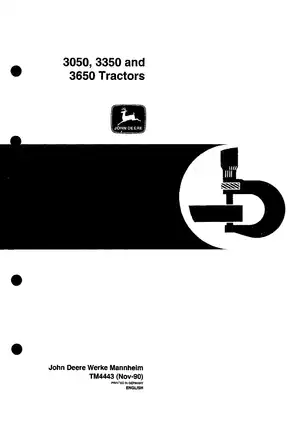
Sample pages from the Official John Deere 3050, 3350 & 3650 Tractor Technical Manual - Comprehensive Maintenance & Repair Procedures - TM4443 manual

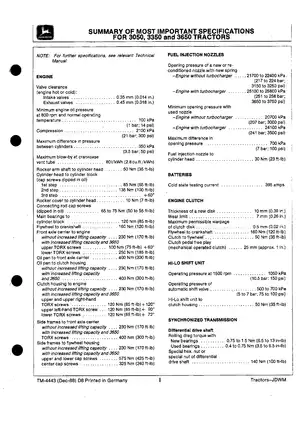
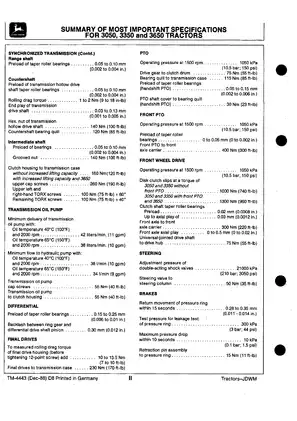
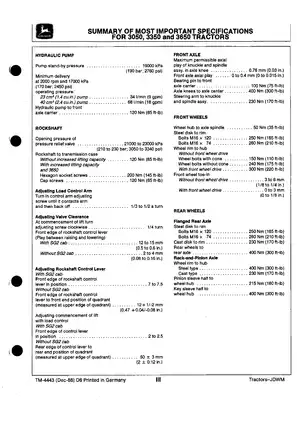
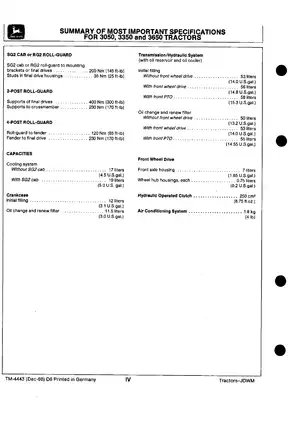
Purchase Information
John Deere 3050, 3350 & 3650 Tractor Technical Manual - Technical Specifications
- Document Number / Seller:
- 30034 / Matthew Lopez
- File Size:
- 37.43 MB
- File Type:
- Language:
- English
- Printable:
- Yes
- Estimated Download Time:
- 0.77 Minutes
- Delivery Format:
- Digital (PDF) - Instant Access
- Category:
- Tractor
- Brand:
- John Deere
- Reviewed and Approved:
- Jan 21, 2025
John Deere Models and Parts Covered in this Tractor Manual
- John Deere 3050
- John Deere 3350
- John Deere 3650
Complete Manual Information
John Deere 3050, 3350 & 3650 Tractor Technical Manual
The John Deere 3050, 3350, and 3650 Tractor Technical Manual offers comprehensive guidance for owners and technicians looking to maintain and repair these powerful tractors. This manual covers everything from safety precautions to detailed specifications that ensure you understand the operation and maintenance of your machine.
Key Features
- Detailed Specifications: Get in-depth information about opening pressure for nozzles and engine performance metrics.
- Comprehensive Service Information: Learn about engine maintenance, hydraulic systems, electrical systems, and power trains.
- Safety Guidelines: Follow essential safety precautions to protect yourself while servicing your tractor.
- Troubleshooting Tips: Expert advice on identifying and resolving common issues that can arise during operation.
What’s Inside
Table of Contents
- Safety
- Important safety alerts and rules.
- General
- Overview of tractor features and specifications.
- Power Train
- Details about the clutch, transmission, and final drives.
- Engine
- Engine care, including cooling and fuel systems.
- Hydraulic System
- In-depth hydraulic service information.
- Steering System and Brakes
- Maintenance and repair processes outlined.
- Electrical System
- Wiring harnesses, lights, and connectivity.
- Miscellaneous
- Extras like operator’s seating and trailer hitches.
This manual is critical for users who need reliable support for their tractors, providing clear, concise instructions to keep your machinery running smoothly
Download Instructions for John Deere Tractor Manual
Frequently Asked Questions - John Deere Tractor Manual
What does this John Deere manual cover?
This comprehensive service manual covers detailed repair procedures, maintenance schedules, troubleshooting guides, and technical specifications for Official John Deere 3050, 3350 & 3650 Tractor Technical Manual - Comprehensive Maintenance & Repair Procedures - TM4443. It includes information for the following models: - John Deere 3050 - John Deere 3350 - John Deere 3650.
Is this manual suitable for beginners?
Yes, this John Deere manual is designed for both professional technicians and DIY enthusiasts. It includes step-by-step procedures with clear illustrations and safety guidelines for Tractor maintenance and repair.
What file format will I receive?
You will receive this manual as a PDF file (37.43 MB), which is compatible with all devices. The manual is fully searchable and printable for your convenience.
How quickly can I access the manual after purchase?
You'll receive instant access to your John Deere Tractor manual immediately after payment completion. The download link is valid for 3 days, with lifetime re-download guarantee.
Does this include hydraulic system information?
Yes, this equipment manual covers hydraulic system operation, maintenance procedures, and troubleshooting for your John Deere machinery.
Can I print specific sections of the manual?
Absolutely! This digital manual allows you to print any section you need, from individual pages to complete chapters, making it perfect for workshop use.
Customer Reviews and Feedback
Read what our customers say about this John Deere Tractor manual and share your own experience.
Add Comment
This policy contains information about your privacy. By posting, you are declaring that you understand this policy:
- Your name, rating, website address, town, country, state and comment will be publicly displayed if entered.
- Aside from the data entered into these form fields, other stored data about your comment will include:
- Your IP address (not displayed)
- The time/date of your submission (displayed)
- Your email address will not be shared. It is collected for only two reasons:
- Administrative purposes, should a need to contact you arise.
- To inform you of new comments, should you subscribe to receive notifications.
- A cookie may be set on your computer. This is used to remember your inputs. It will expire by itself.
This policy is subject to change at any time and without notice.
These terms and conditions contain rules about posting comments. By submitting a comment, you are declaring that you agree with these rules:
- Although the administrator will attempt to moderate comments, it is impossible for every comment to have been moderated at any given time.
- You acknowledge that all comments express the views and opinions of the original author and not those of the administrator.
- You agree not to post any material which is knowingly false, obscene, hateful, threatening, harassing or invasive of a person's privacy.
- The administrator has the right to edit, move or remove any comment for any reason and without notice.
Failure to comply with these rules may result in being banned from submitting further comments.
These terms and conditions are subject to change at any time and without notice.
Comments (3)